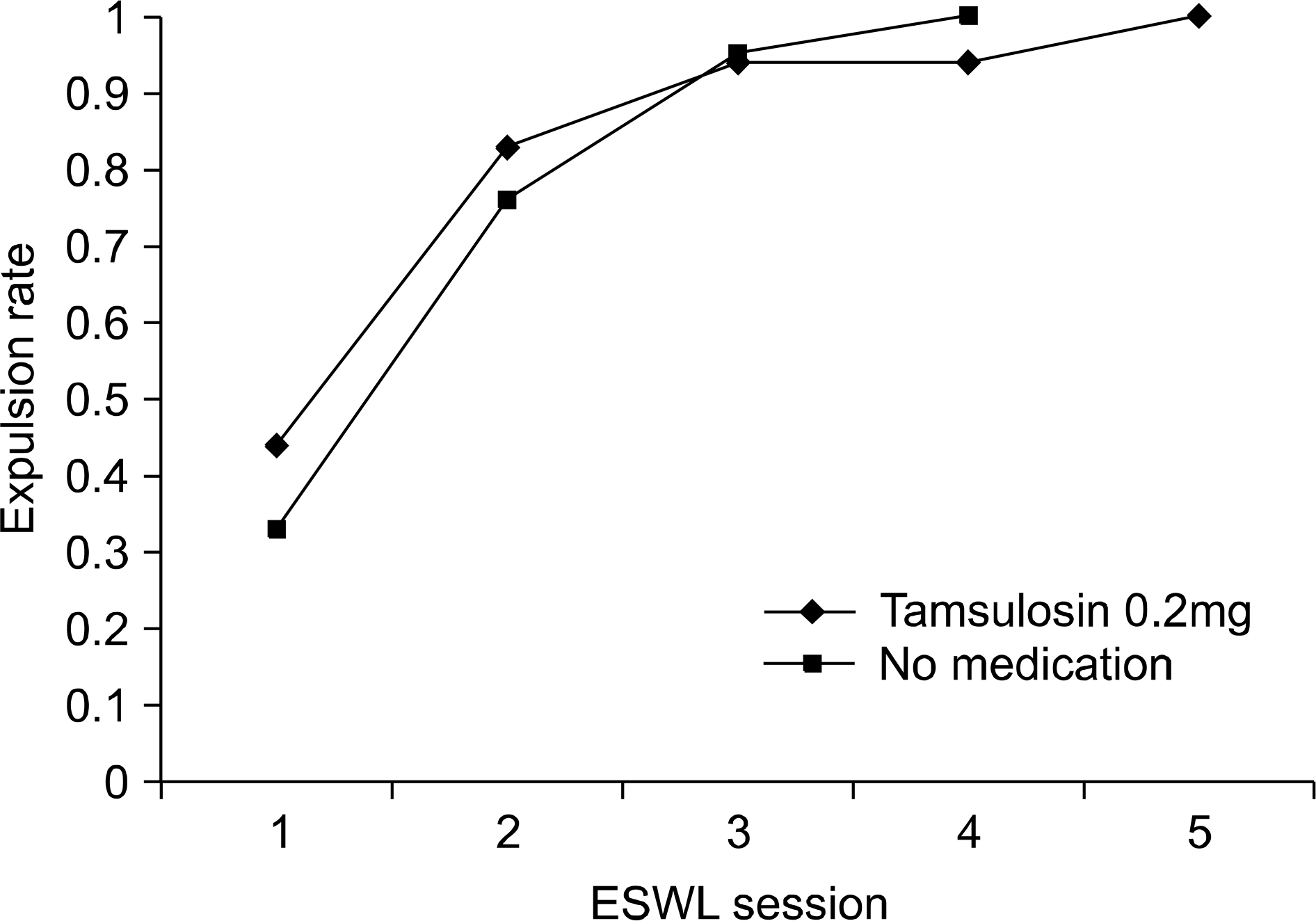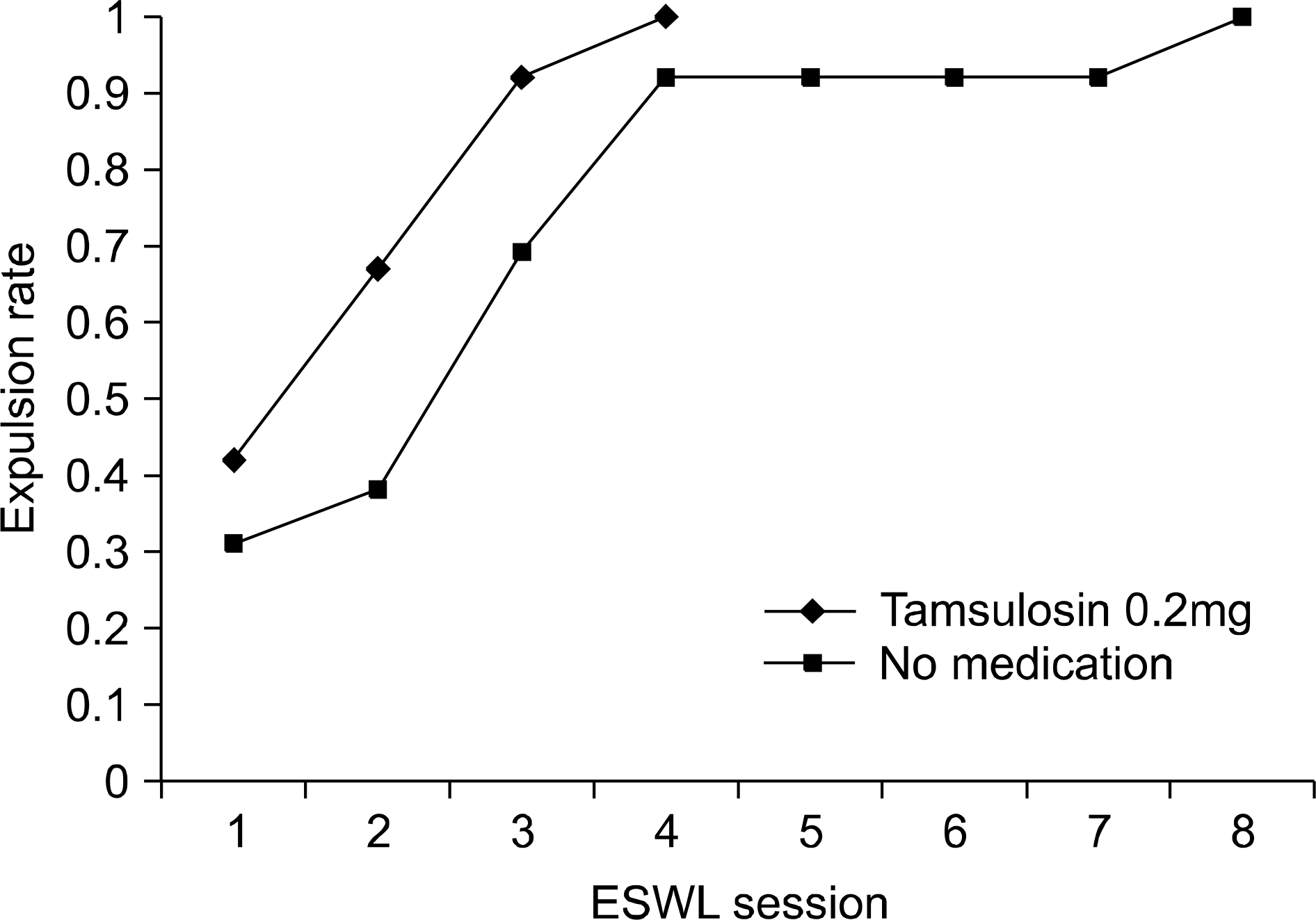Abstract
Purpose
The aim of this study was to evaluate the effect of tamsulosin on expulsion of ureteral stones after extracorporeal shock wave lithotripsy (ESWL).
Materials and Methods
Seventy-six patients (39 with upper ureteral stones and 37 with lower ureteral stones) treated with ESWL for stones <10mm were randomly divided into two groups. Tamsulosin (0.2mg orally once daily) was administered to group 1; group 2 received no medications. All patients were evaluated with respect to the number of episodes of ureteral colic, the expulsion rates of stones after ESWL, and the mean number of sessions of ESWL until complete expulsion of stones.
Results
The complete expulsion rates of upper and lower ureteral stones did not differ significantly between groups 1 and 2 during each session of ESWL; however, the mean session of ESWL was lower in group 1 than in group 2. For upper ureteral stones, 1.8 sessions were necessary per patient in group 1, while 2.3 sessions were required for the patients in group 2 (p=0.039). For lower ureteral stones, 2.0 sessions were necessary per patient in group 1, while 2.9 sessions were required for the patients in group 2 (p=0.032). There were significant decreases in the number of episodes of pain in group 1 with lower ureteral stones (p=0.014). There were no side effects associated with tamsulosin.
Conclusions
The use of tamsulosin in the treatment of upper and lower ureteral stones after ESWL can decrease the mean number of sessions of ESWL and the number of episodes of pain, but cannot improve the expulsion rate. Further research regarding the cost-effectiveness of tamsulosin after ESWL is needed.
Go to : 
References
1. Yilmaz E, Batislam E, Basar MM, Tuglu D, Ferhat M, Basar H. The comparison and efficacy of 3 different alpha-1 adrenergic blockers for distal ureteral stones. J Urol. 2005; 173:2010–2.
2. Preminger GM, Tiselius HG, Assimos DG, Alken P, Buck C, Gallucci M, et al. 2007 guideline for the management of ureteral calculi. J Urol. 2007; 178:2418–34.

3. Danuser H, Weiss R, Abel D, Walter B, Scholtysik G, Mettler D, et al. Systemic and topical drug administration in the pig ureter: effect of phosphodiesterase inhibitors alpha1, beta and beta2-adrenergic receptor agonists and antagonists on the frequency and amplitude of ureteral contractions. J Urol. 2001; 166:714–20.
4. Peters HJ, Parekh N, Popa G. Effect of adrenergic and cholinergic agents on ureteral functions in dogs. Urol Int. 1979; 34:137–46.
5. Hancock AA. α1-adrenoreceptor subtypes: a synopsis of their pharmacology and molecular biology. Drug Dev Res. 1996; 39:54–107.
7. Bak CW, Yoon SJ, Chung H. Effects of an α-blocker and terpene mixture for pain control and spontaneous expulsion of ureter stone. Korean J Urol. 2007; 48:517–21.

8. Han MC, Park YY, Shim BS. Effect of tamsulosin on the expectant treatment of lower ureteral stones. Korean J Urol. 2006; 47:708–11.

9. Resim S, Ekerbicer HC, Ciftci A. Role of tamsulosin in treatment of patients with steinstrasse developing after extracorporeal shock wave lithotripsy. Urology. 2005; 66:945–8.

10. Chaussy C, Schmiedt E, Jocham D, Brendel W, Forssmann B, Walther V. First clinical experience with extracorporeally induced destruction of kidney stones by shock waves. J Urol. 1982; 127:417–20.

11. Porpiglia F, Destefanis P, Fiori C, Fontana D. Effectiveness of nifedipine and deflazacort in the management of distal ureteral stones. Urology. 2000; 56:579–82.
12. Porpiglia F, Ghignone G, Fiori C, Fontana D, Scarpa RM. Nifedipine versus tamsulosin for the management of lower ureteral stones. J Urol. 2004; 172:568–71.

13. Hussain Z, Inman RD, Elves AW, Shipstone DP, Ghiblawi S, Coppinger SW. Use of glyceryl trinitrate patches in patients with ureteral stones: a randomized, double-blind, placebocontrolled study. Urology. 2001; 58:521–5.

14. Malin JM Jr, Deane RF, Boyarsky S. Characterisation of adrenergic receptors in human ureter. Br J Urol. 1970; 42:171–4.
15. Morita T, Wada I, Saeki H, Tsuchida S, Weiss RM. Ureteral urine transport: changes in bolus volume, peristaltic frequency, intraluminal pressure and volume of flow resulting from autonomic drugs. J Urol. 1987; 137:132–5.

16. Cervenakov I, Fillo J, Mardiak J, Kopecny M, Smirala J, Lepies P. Speedy elimination of ureterolithiasis in lower part of ureters with the alpha1-blocker tamsulosin. Int Urol Nephrol. 2002; 34:25–9.
17. Dellabella M, Milanese G, Muzzonigro G. Efficacy of tamsulosin in the medical management of juxtavesical ureteral stones. J Urol. 2003; 170:2202–5.

18. Kupeli B, Irkilata L, Gurocak S, Tune L, Kirac M, Karaoglan U, et al. Does tamsulosin enhance lower ureteral stone clearance with or without shock wave lithotripsy? Urology. 2004; 64:1111–5.

19. Resim S, Ekerbicer H, Ciftci A. Effect of tamsulosin on the number and intensity of ureteral colic in patients with lower ureteral calculus. Int J Urol. 2005; 12:615–20.

20. O'Leary MP. Tamsulosin: current clinical experience. Urology. 2001; 58:42–8.
Go to : 
 | Fig. 1.There was no difference in the cumulative expulsion rate between the group administered tamsulosin and the no medication group after extracorporeal shock wave lithotripsy (ESWL) involving upper ureteral stones. |
 | Fig. 2.There was no difference in expulsion rates between the group administered tamsulosin and the no medication group after extracorporeal shock wave lithotripsy (ESWL) involving lower ureteral stones. |
Table 1.
Patient characteristics
Table 2.
Comparison of stone size, intervals between sessions of ESWL, and mean number of sessions of ESWL
Table 3.
Comparison of the expulsion rate at each ESWL session




 PDF
PDF ePub
ePub Citation
Citation Print
Print


 XML Download
XML Download